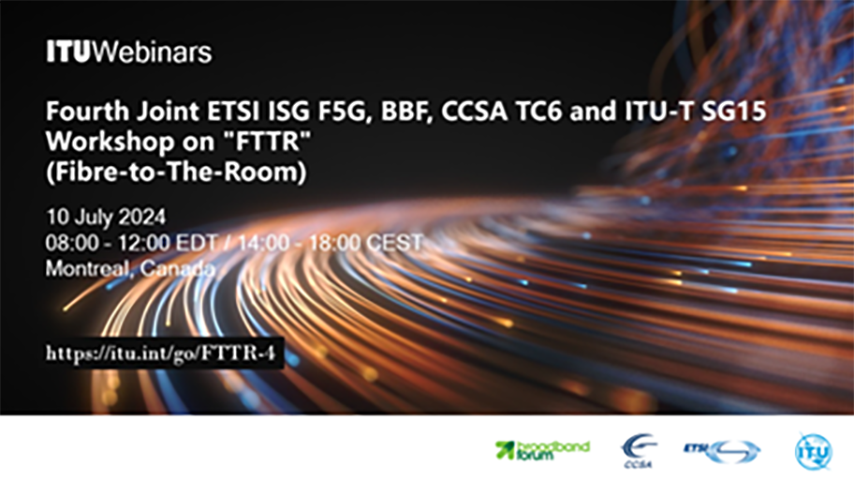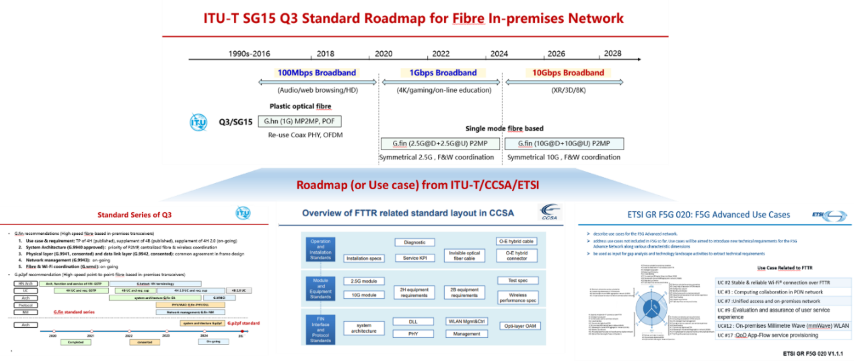Global SDOs collaborate to advance FTTR: Highlights from Fourth Joint Workshop of ETSI ISG F5G, BBF, CCSA TC6 and ITU-T SG15
The International Telecommunication Union (ITU) together with the European Telecommunications Standards Institute – Industry Specification Group -Fifth Generation Fixed Network (ETSI ISG F5G), the Broadband Forum (BBF), and the China Communications Standards Association – Technical Committee 6 (CCSA TC6) organized the Fourth Joint ETSI ISG F5G, BBF, CCSA TC6 and ITU-T SG15 Workshop on "FTTR" (Fibre to the room), which took place 10 July 2024 from 8:00-12:00 (EDT)/14h00 to 18h00 (CEST) in Montreal, Canada.
The use case of on-premises fibre networks, such as FTTR, was firstly described in ETSI GR F5G 002 by the ISG F5G early in 2020. Since then, the related standards have been rapidly developed by several Standard Development Organisations (SDOs). The workshop intend was to offer the opportunity to continue the discussion on FTTR and other on-premises fibre networks for all the involved stakeholders, to reach a better common understanding of the use cases, the requirements, the deployment challenges, and the best practices. This workshop facilitates the development of an FTTR standard and the cooperation of multiple SDOs, as well as the system deployment by the network operators.

There were three sessions in the workshop: standard development of FTTR, views of service provider, and FTTR technology.
1. Sharing of the standard development status of the different SDOs & exploring the potential collaboration for dedicated topics:

- Tony Zeng (Associate Rapporteur of ITU-T SG15 Q3) reported the progress of the standard in ITU-T SG15 Q3, and emphasised that the in-premises fibre network standards are evolving from 1Gbps to 10 Gbps, including the key coordination technology between fibre and wireless access.
- Frank Effenberger (Rapporteur of ITU-T SG15 Q2) presented how FTTR was innovated from PON technologies and standards defined in ITU-T SG15 Q2.
- Jason Walls (Director of BUS Work Area, BBF) introduced the User Services Platform (USP) in BBF, and its related standards that can be applied to Wi-Fiâ management for FTTR. He also emphasised the importance of sticking with aligned industry standards on FTTR.
- Qiang Cheng (CAICT) reported the progress of the standard and the roadmap of FTTR in CCSA TC6 in China, and proposed to accelerate FTTR standardisation to match the marketing needs.
- Olivier Ferveur (Chair of ETSI ISG F5G) showed the ISG F5G standards work to promote the evolution towards F5G-A. He highlighted several F5G-A FTTR Use Cases, and introduced the next steps on test specifications for FTTR functionality and performance.
- Olivier Bouffant (Chair of ETSI TC ATTM WG AT2) introduced the fibre infrastructure standards defined in TC ATTM WG AT2, including the single mode optical fibre system, and the fibre deployment for fibre-based in-premises networking.
2. Understand the user cases, network requirements, deployment challenges & evolution desire from service provider:
- Philippe Chanclou (Orange) introduced the Optical Home LAN, an emerging connectivity, and explained that PON and PtP are the ideal companions of Wi-Fiâ in-house backhaul because of the throughput, jitter and latency performance.
- Ning Wang (China Mobile) introduced the pathway from Gigabit to 10-Gigabit, with the key technologies of 50GPON, FTTR and Wi-Fiâ7 which can provide E2E 10Gbps and guarantee user experience.
- Qizheng Li (China Telecom) presented the FTTR market prospects in various business scenarios, and introduced the key requirements and technologies for FTTR-B.
- Yue Sun (China Unicom) introduced new FTTR technologies such as Millimetre Wave and sensing. Hai Ding (China Unicom) introduced the practices and experience of managing massive FTTR systems in China Unicom.
3. Discussion of the advanced technologies for fibre in-premises network for future evolution and coordination with last 10-meters WLAN:
- Huanyu Li (SDGI) introduced the deployment of indoor cabling system based on invisible optic cables or Optical/Electrical Hybrid Cable, with advantages of stickiness network, no fusion and easy pass through pipe, and no independent power connection, etc.
- Debin Hou (MISIC Microelectronics Co. Ltd) introduced the Millimetre Wave Integrated Chips and systems in the FTTR application.
- Jan Hesselbarth (University of Stuttgart) introduced the Passive FTTR distribution system using Millimetre Wave on polymer fibre, with the advantages of low transmission loss, low-cost, low-weight, mechanical-flexible, and touching-ok.
- Volker Jungnickel (Fraunhofer HHI) introduced the Li-Fi in industrial and medical applications, and highlighted that FTTR + Li-Fi will be the next-generation in-building backbone technologies.
The agenda and the presentations can be found below:
https://www.itu.int/en/ITU-T/Workshops-and-Seminars/2024/0710/Pages/default.aspx

